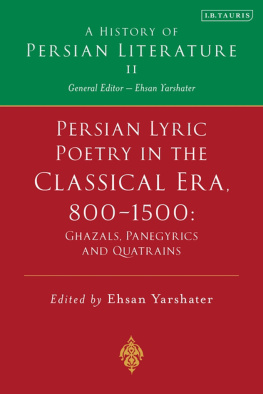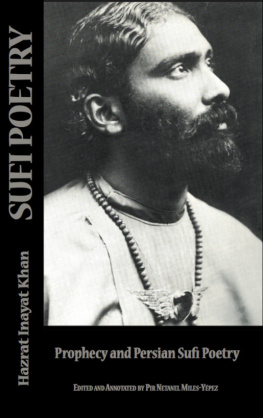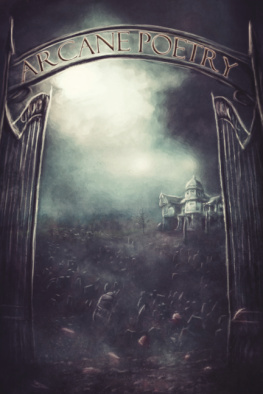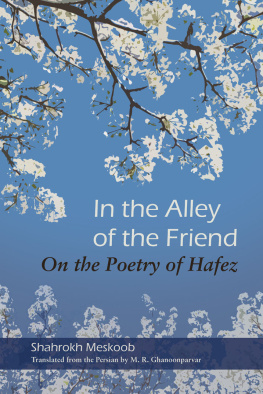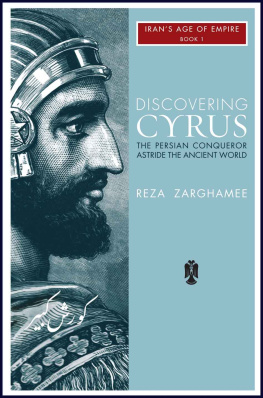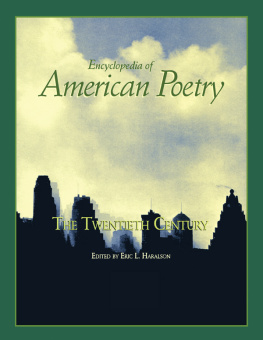About the Authors
Rob Simms is a multi-instrumentalist and author of The Repertoire of Iraqi Maqam and co-author (with Amir Koushkani) of The Avaz of Mohammad Reza Shajarian in Iran and Beyond (19792010). He is Associate Professor of Music at York University in Toronto.
Amir Koushkani is a performer (solo and in collaboration with other musicians), composer, arranger, and instructor of the traditional Persian stringed instruments tar and setar. He is a PhD candidate in ethnomusicology at York University, Toronto.
Appendix 1
Contemporary Conventions of Avaz Performance
While there are plenty of good introductory texts offering an overview of the performance tradition of Persian music, this appendix presents an abbreviated, basic orientation for those readers unfamiliar with it.
Despite... signs of modernity, most Iranian musics remain attached to what musicians have defined as the immutable frames or axes of tradition. The slight changes in intervals foreseen by Vazr have been adopted only in theoretical treatises, modes have been preserved, and, even more curiously, no mode or modal type has been added for more than 150 years. The main instruments are still those of the nineteenth century, scarcely changed, despite the appearance of many new instruments, both Western (piano, violin, flute) and Eastern (d, qnn, and rabb). Poetry and song still mobilize the public, and the sung ghazal remains the center of any musical performance, so much so that instrumentalists, breaking with the traditional separation of functions, have also begun to sing tanif-h, solo or in a group, at the end of their concerts. (During 2002:863)
The Radif
The radif is a collection of two to three hundred (depending on the rescension of a particular line of transmission) melodies called gushes (pronounced gsheh). Some as short as ten seconds, others lasting a few minutes; most are in free rhythm but some are metrical; each are given a proper name. These melodies are memorized by musicians and used as models upon which they improvise and compose. The melodies are organized in an explicitly holonic fashion into specific groupings within which they have a specific order, which is reasonably consistent between the various rescensions. This organization can be introduced effectively to neophytes through an analogy to computer terminology wherein the gushes are individual files. The total aggregate of 200 to 300 files on a hard drive is the radif, which are distributed into seven folders known as dastgahs. Two of these main dastgah folders contain subfolders known as avaz: the main dastgah folder Shur has four avaz subfolders and Homayun has one, making a total of twelve folders and subfolders within which the individual gushe files are situated. While identical or similar file names exist within the various folders, the contents of these files are never identical. Files within each folder are often chunked into groupings of related contents. Some files are more important than others.
The Suite Tradition and Its Components and Accompaniment
Supposedly established by Darvish Khan, contemporary practice Persian music consists of a juxtaposition of improvised and composed, nonmetric and metric, instrumental and vocal sections that form a kind of suite. The key aesthetic consideration appears to be contrast. The improvised, nonmetric avaz sections are framed by various composed instrumental forms such as the introductory pishdaramad, the up-tempo chaharmezrab, the dance-like reng, and the vocal tasnif, strophic or through-composed metrical settings of poetry, and occasionally short compositions that function as interludes between avaz sections. An entire suite can last anywhere between twenty to sixty minutes and generally follows the scheme: pishdaramad/chaharmezrab; avaz; interlude/tasnif; avaz; concluding tasnif and/or reng (see Zonis 1973 and During 1984 for detailed descriptions of these forms). Shajarians performances generally follow this format, though he began experimenting with the ordering in the early 2000s. Avaz sections are central in the scheme of the suite, while the composed sections primarily function to highlight the avaz and are more or less optional.
Excluding vocal radifs, avaz is almost always accompanied by a traditional Persian instrument, most often tar, setar, ney, santur or kamanche (for descriptions of these instruments, see During 1984; Zonis 1973). The accompanist instantaneously mirrors the melody of the singer, and provides instrumental interludes (jawabs, lit. answers) between couplets or single misras (hemistiches). Avaz accompaniment is a demanding practice which requires fast reflexes and an excellent memory, as the accompanist must duplicate or mirror the singer instantaneously; this results in a slight delay and heterophonic (theoretically, quasicanonic) overlap of the two lines. The accompanist must also remember the overall shape of the avaz phrase, which she then paraphrases during the jawab interlude. While such a paraphrase is expected, it is acceptable to present completely contrasting material, so long as it maintains the modal identity of the sung phrase. Jawabs function to provide musical and dramatic relief from the intensity of the avaz, rest for the singer, and allow the listener time to reflect on the poetic content of the sung phrase. Operating similar to the composed sections of a full performance of contemporary Persian music but scaled to a lower structural level, jawabs function to frame and highlight sections.
Free Meter
The rhythmic structure of avaz is nonmetrical and complex. While metrically free, short portions often have a defnite sense of pulse, the tempo of which can vary considerably between successive portions. Other more complex sections are based on the rhythm inherent in the text and are difficult to define in terms of musical rhythm. The density of rhythmic articulation varies from what may be very loosely interpreted as sixteenth notes to dotted whole notes. Tahrirs, the extended melismata that idiomatically employ the glottal tekye appogiatura, are largely based on a fast steady pulse, and therefore highly rhythmical. They are textless, usually sung to a long or vowel.
Phrase Construction
Melody is generated and regulated by the modal theory of dastgah, with the gushe functioning as the most directly practical hierarchical level of the modal system. A gushe is a model composition containing all the defmitive modal characteristics such as ambitus, functional pitches, chromatic alternation, background melodic contour and motivic materials. Once memorized it is the basis from which the performer improvises, developing the model from his inductive understanding of the modal parameters. Having selected the dastgah beforehand, the singer then chooses from the gushes (submodes) that collectively constitute the dastgah. While the choice is theoretically free, in practice it is predetermined by the conventions of performance. These conventions are not explicitly articulated in theory, but invariably include certain important submodes (shh gushes). While these choices are often made beforehand (additional preset or compositional parameters of the performance), spontaneous choices could, and some connoisseurs might say should, be included.
With the selected melodic materials and the poem at hand, the singer proceeds spontaneously to weave the two into a distinct third entity. In the process of setting the poem afresh, the singer draws upon the experience and models of many memorized gushes, which in a vocal radif include guidelines for stylistically idiomatic textual underlay. The acquisition of the skill of text setting is, like that of nontextual, purely melodic improvisation, a process of creatively reconstructing and rearranging the poem with the tools and knowledge inductively learned from the radif.


